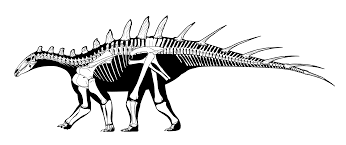Post by dinosauria101 on May 27, 2019 16:45:25 GMT 5
European Hippopotamus - Hippopotamus antiquus
Hippopotamus antiquus, sometimes called the European hippopotamus, was a species of hippopotamus that ranged across Europe, becoming extinct some time before the last ice age at the end of the Pleistocene epoch. H. antiquus ranged from the Iberian Peninsula to the British Isles to the Rhine River to Greece. Similar in size and form to Hippopotamus gorgops, H. antiquus on average was larger than the modern common hippopotamus (Hippopotamus amphibius). H. antiquus is believed to have first appeared around 1.8 million years ago, compared to 2 million years ago for H. amphibius. Beginning in the Middle Pleistocene, H. amphibius migrated into Europe and may have competed with this hippopotamus species for food. The Cretan Dwarf Hippopotamus (H. creutzburgi) is believed to have evolved from H. antiquus through the process of insular dwarfism on the island of Crete. Martínez-Navarro et al. (2004) estimated a body mass for H. antiquus between 2.500-4000 Kg, which is more than two times heavier than the mean weight of its extant relative.

Dacentrurus armatus
Dacentrurus (meaning "tail full of points"), originally known as Omosaurus, was a large stegosaur of the Late Jurassic Period (154 - 150 mya) of Europe. Its type species, Omosaurus armatus, was named in 1875, based on a skeleton found in the Kimmeridge Clay of England. In 1902 the genus was renamed Dacentrurus because the name Omosaurus had already been used for a crocodylian. After 1875, half a dozen other species would be named but perhaps only Dacentrurus armatus is valid. Finds of this animal have been limited and much of its appearance is uncertain. It was a heavily built quadrupedal herbivore, adorned with plates and spikes. Dacentrurus was a large stegosaurid. Some specimens reached lengths 10 meters (33 ft) and weighed 8 t (8.8 short tons). Many books claim that Dacentrurus was a small stegosaur, when in fact finds such as a 1.5 metres (4.9 ft) wide pelvis indicate that Dacentrurus was among the largest of them. For a stegosaur the gut was especially broad, and a massive rump is also indicated by exceptionally wide dorsal vertebrae centra. The hindlimb was rather short, but the forelimb relatively long, largely because of a long lower arm. Although Dacentrurus is considered to have the same proportions as Stegosaurus, its plate and spike configuration is known to be rather different, as it probably had both two rows of small plates on its neck and two rows of longer spikes along its tail. The holotype specimen of Dacentrurus armatus contained a small blunt asymmetrical neck plate and also included a tail spike which could have been part of a thagomizer. The tail spike had sharp cutting edges on its front and rear side. Dacentrurus has sometimes been portrayed with a spike growing near the shoulder, similarly to a Kentrosaurus. Whether this portrayal is accurate or not is not yet determined.

Credit to Wikipedia
Hippopotamus antiquus, sometimes called the European hippopotamus, was a species of hippopotamus that ranged across Europe, becoming extinct some time before the last ice age at the end of the Pleistocene epoch. H. antiquus ranged from the Iberian Peninsula to the British Isles to the Rhine River to Greece. Similar in size and form to Hippopotamus gorgops, H. antiquus on average was larger than the modern common hippopotamus (Hippopotamus amphibius). H. antiquus is believed to have first appeared around 1.8 million years ago, compared to 2 million years ago for H. amphibius. Beginning in the Middle Pleistocene, H. amphibius migrated into Europe and may have competed with this hippopotamus species for food. The Cretan Dwarf Hippopotamus (H. creutzburgi) is believed to have evolved from H. antiquus through the process of insular dwarfism on the island of Crete. Martínez-Navarro et al. (2004) estimated a body mass for H. antiquus between 2.500-4000 Kg, which is more than two times heavier than the mean weight of its extant relative.

Dacentrurus armatus
Dacentrurus (meaning "tail full of points"), originally known as Omosaurus, was a large stegosaur of the Late Jurassic Period (154 - 150 mya) of Europe. Its type species, Omosaurus armatus, was named in 1875, based on a skeleton found in the Kimmeridge Clay of England. In 1902 the genus was renamed Dacentrurus because the name Omosaurus had already been used for a crocodylian. After 1875, half a dozen other species would be named but perhaps only Dacentrurus armatus is valid. Finds of this animal have been limited and much of its appearance is uncertain. It was a heavily built quadrupedal herbivore, adorned with plates and spikes. Dacentrurus was a large stegosaurid. Some specimens reached lengths 10 meters (33 ft) and weighed 8 t (8.8 short tons). Many books claim that Dacentrurus was a small stegosaur, when in fact finds such as a 1.5 metres (4.9 ft) wide pelvis indicate that Dacentrurus was among the largest of them. For a stegosaur the gut was especially broad, and a massive rump is also indicated by exceptionally wide dorsal vertebrae centra. The hindlimb was rather short, but the forelimb relatively long, largely because of a long lower arm. Although Dacentrurus is considered to have the same proportions as Stegosaurus, its plate and spike configuration is known to be rather different, as it probably had both two rows of small plates on its neck and two rows of longer spikes along its tail. The holotype specimen of Dacentrurus armatus contained a small blunt asymmetrical neck plate and also included a tail spike which could have been part of a thagomizer. The tail spike had sharp cutting edges on its front and rear side. Dacentrurus has sometimes been portrayed with a spike growing near the shoulder, similarly to a Kentrosaurus. Whether this portrayal is accurate or not is not yet determined.
Credit to Wikipedia




